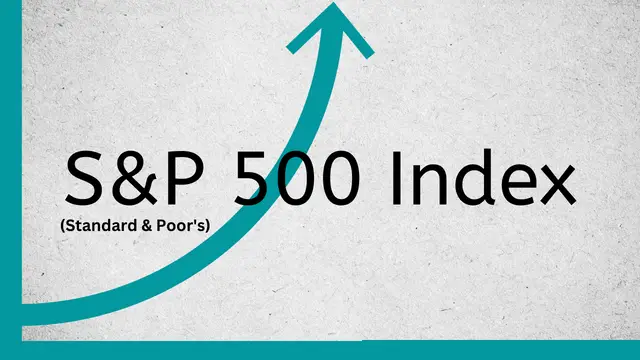This post may contain affiliate links; please see our disclaimer for details.
When Warren Buffet talks, we all tend to listen. So, it’s no surprise when he talks about the S&P 500 as a reliable investing choice that people want to learn more about it.
This article provides a solid background for understanding what the S&P 500 is, why Warren Buffet recommends it, how to invest in it, and much more!
Table of Contents
What is the S&P 500?

The Standard & Poor’s 500, or S&P 500 for short, is an index containing 500 large-cap stocks. It’s considered a benchmark for the stock market, and it’s often used to gauge the overall market’s performance.
The main thing that makes the S&P 500 attractive to investors is its diversified index. This means that it’s made up of various stocks, which helps mitigate risk.
If interested, I created another article describing The Difference Between Mutual Funds, ETFs, and Index Funds.
Why did Warren Buffett recommend the S&P 500?

The answer to that question is quite simple: he believes it’s a good investment.
Warren Buffett once said, “In my view, for most people, the best thing is to do is owning the S&P 500 index fund”.
There are a few reasons why Buffett thinks the S&P 500 is a good investment.
First, he likes that it’s a diversified index. As we mentioned before, this helps to mitigate risk.
Second, Buffett likes the S&P 500 because it’s a long-term investment. This is something that he’s always been a big proponent of. He believes you should invest long-term and not try to time the market.
Lastly, Buffett likes the S&P 500 because it has a history of outperforming actively managed mutual funds. Over the long run, the S&P 500 has consistently outperformed mutual funds. This is likely because mutual fund managers often make poor investment decisions.
Which S&P 500 funds does Warren Buffet own?
Warren Buffet owns a few different S&P 500 index funds. These include the Vanguard 500 Index Fund (VOO) and the SPDR S&P 500 ETF (SPY).
Why does he own these funds in Berkshire Hathaway?
The answer to this question is twofold. First of all, as mentioned before, Buffett is a big proponent of index investing. By owning these funds, he can get exposure to the S&P 500 without picking individual stocks.
Secondly, Berkshire Hathaway is a large holding company. This means that it can hold a lot of different stocks and not be as impacted by the performance of any one stock.
How much can you earn with the S&P 500?

You can earn 10% on average with the S&P 500. This return is based on the historical average return of the index. Of course, depending on the overall market’s performance, you can earn more or less than 10%.
You’ll likely make more than 10% if the market does well. However, if the market does poorly, you could earn less.
It’s possible to earn even more than 10% if you invest in a fund that tracks the S&P 500. Some examples include VOO and SPY.
So it’s essential to start investing as soon as possible and consistently over the years. My wife and I started in our early 20’s and have loved the S&P 500 index fund. The power of compound interest will work wonders for you.
You may wonder how much you would need to invest in the S&P 500 each month to become a millionaire. I’ve put together the following numbers based on an annual 10% rate of return, starting with zero money in investments and retiring at the age of 60.
| Age | Monthly Investment Amount |
| 20 | 160 |
| 25 | 270 |
| 30 | 450 |
| 35 | 770 |
| 40 | 1330 |
| 45 | 2425 |
| 50 | 4900 |
You can try many more scenarios using the Dave Ramsey Investment Calculator! We love this calculator and have used it many times to help us stay on track and adjust when necessary.
How Much Does It Cost to Invest in the S&P 500?
It doesn’t cost much to invest in the S&P 500. You can invest in it through index funds or ETFs.
If you’re looking for the cheapest way to invest in the S&P 500, Vanguard’s S&P 500 ETF (VOO) has an expense ratio of 0.03%, while the Vanguard 500 Index Fund Admiral Shares (VFIAX) has an expense ratio of 0.04%. So, you can see that it doesn’t cost much to invest in these index funds.
Do S&P 500 ETFs and Funds Pay a Dividend?

Yes, both S&P 500 ETFs and index funds pay a dividend. The dividend yield on the S&P 500 is around 2%.
If you invest $10,000 in the S&P 500, you can earn $200 in dividends yearly. But, of course, this number will fluctuate depending on the overall market’s performance.
What Are the Risks of Investing in the S&P 500?
You should be aware of a few risks before investing in the S&P 500.
First, it’s important to remember that the stock market is volatile. This means that it can go up or down at any time.
If you’re investing long-term, this shouldn’t be too much of a concern. However, if you need your money sooner, you should be aware of the risks.
Another risk to consider is the fact that you’re investing in a basket of 500 stocks. This means that if one stock goes down, it could significantly impact your investment.
To mitigate this risk, you can invest in an S&P 500 index fund or ETF. This will help to diversify your investment and reduce the impact of any one stock.
As with any investment, there’s risk involved. You’ll find that generally speaking, the S&P 500 is a fairly safe investment. However, it would be best if you always did your own research before investing in anything.
Should I invest in S&P 500?
Warren Buffet thinks so! The S&P 500 has outperformed mutual funds over the long run. This is likely because mutual fund managers often make poor investment decisions.
Index investing is a much simpler way to invest. You don’t have to worry about picking individual stocks. Instead, you can get exposure to the entire market by investing in an S&P 500 index fund or ETF.
The problem with choosing another form of investing is that you have to outsmart the market. This is a difficult task for even the most experienced investors.
If it were so easy, everyone would be like Warren Buffett. If you want to mitigate the risk as much as possible, invest in the S&P 500.
Diversity is your friend when it comes to investing. Remember, the S&P 500 is made up of 500 different stocks. This provides you with a good level of diversification.
Many people enjoy the strategy of investing in the S&P 500. It’s a simple and effective way to get exposure to the stock market. Plus, it doesn’t require you to outsmart the market.
If you’re looking for a simple and effective way to invest, the S&P 500 is a great choice!
Disclaimer:
We hope the information in this article provides valuable insights to every reader but we, the Biesingers, are not financial advisors. When making your personal finance decisions, research multiple sources and/or receive advice from a licensed professional. As always, we wish you the best in your pursuit of financial independence!

